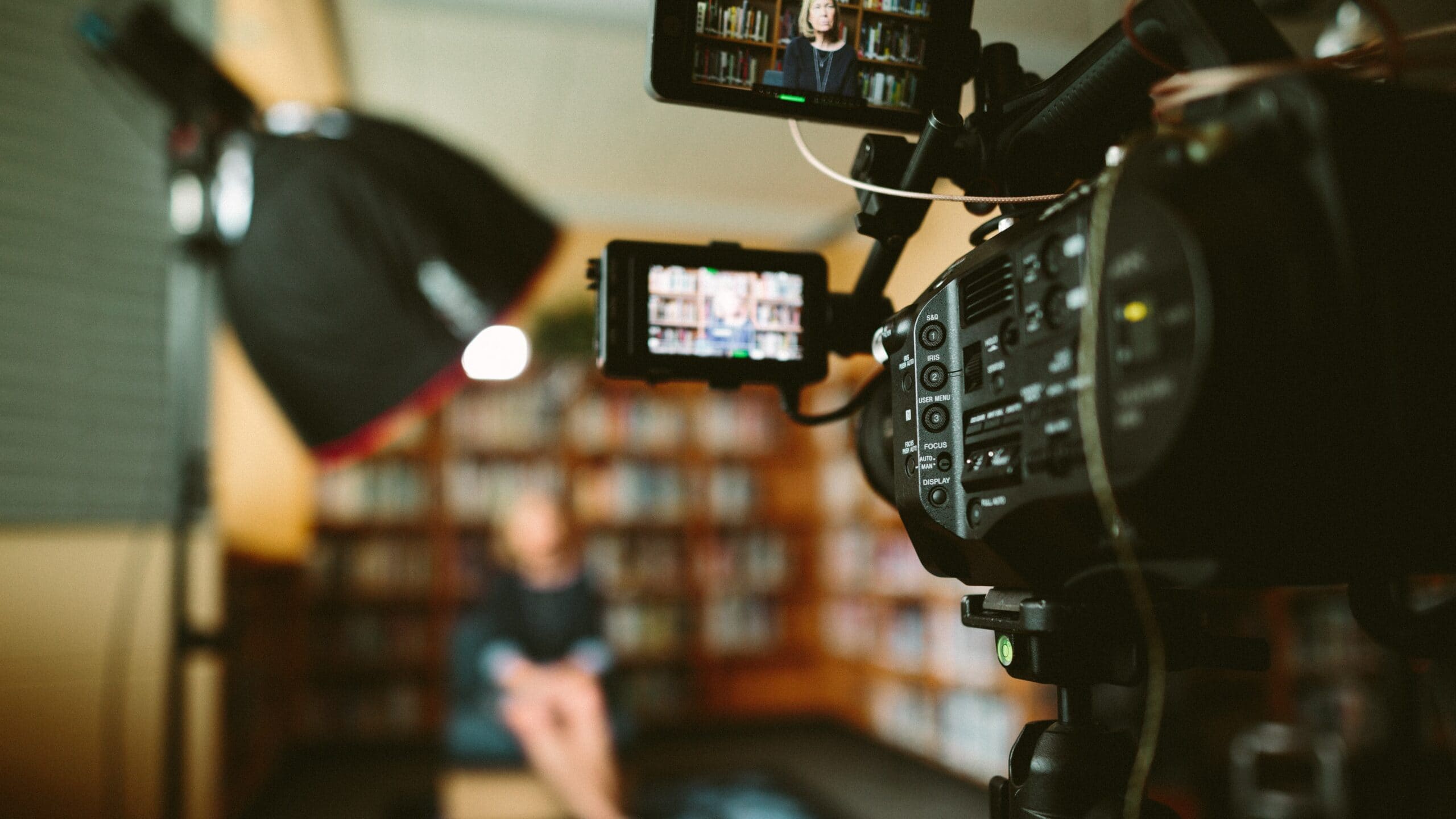Video production is basically the process of creating video content for use in multimedia projects with a target audience in mind. There are many different aspects of video production.
In today’s online world where watching videos are considered the norm and are just one tap away on our smartphones, just about everything needs a video. Keep in mind a video can increase traffic by over 150%!
The most common types of video productions include film and TV production, television commercials, internet commercials, corporate videos, product videos, customer testimonial videos, marketing videos, event videos, wedding videos, and explainer videos.
The process of creating a video involves capturing moving images (such as through a movie camera) or still images (as with a digital single-lens reflex camera), along with recording sound and often additional related information about the scenes being filmed such as dialogue, music, and sound effects.
Video production can be broken down into three main subcategories. Pre-Production, Production, and Post-Production.
Pre-Production Phase Basics. It’s time to plan!
The Pre – Production stage entails all of the planning elements and preparations that are needed before the actual shooting for the video project begins. In other words, this is where the Video Strategy is created and the planning and preparation stage is completed prior to any recording is created.
The script is the blueprint to a great video production
The Pre – Production stage is the time where the idea is formulated, a script is written, storyboards are created, the cast and or props are chosen and the audio and video team needed to create the video are chosen. There are literally a myriad of things that go into pre-production of good video production- all with the audience in mind.
All great video productions start with a script and storyboard. This will create the tone of the video, the message the video conveys, the visual layout of how the scenes will look and feel when the video is being recorded.
A well-written script dials in on the message and feeling the video wants to get across to the viewer. This is perhaps one of the most important parts of great video production. No video should start without it.
Some videos make you laugh, some make you sad, others make you want to get up and move. The script and storyboard are the keys to creating great and intentional emotion in your video production.
What is a storyboard?
The storyboard creates a visual layout of how each scene will look when it’s being recorded. Video producers use this to catch the “look and feel” of the entire video prior to filming and also assist in determining all the internal and external components needed to create the video prior to filming.
Where is the video being shot?
Depending on the type of video that is being produced, other factors during the video pre-production phase could be where the locations of the scene or scenes, indoor or outdoor, lighting (is it sunlight or artificial lighting?), time of day, weather conditions. Many decisions are made during the pre-production phase.
Location scouting entails finding possible locations for shooting your video content, whether indoors or outdoors, depending on the types of videos. You need to take note of safety issues (i e risky areas), legalities (i .e permits required), weather conditions, time restrictions, among others, before choosing which one would work best for you.
Does your video include characters and costumes?
Another area of pre-production could include the costumes of the characters in the video. If you decide on costumes you will need to need to decide on what costumes would work best for each character as this is going to define their personalities as well as how they look in general.
Video producers also keep an eye of for detail on how the background actors dress up and the extras needed in the video too. Everything in your video shoot should work and fit together.
Actors may need a make-up artist
Another thing to consider, if you have actors in a video, there will most likely be a need for makeup. If you have a makeup artist, you will need to decide which type of make-up should be used, from hair styling down to applying fake tattoos or scars, among others.
Will there be animals in the video?
Some productions may require animals and this would require that planning also. Animals can make better videos because they’re more natural than humans. They’re real; they’re relatable. And they’re fun!
Just a note here, dogs are by far the most used animal in videos and make up about 44% of all animals used in video production. It’s been said a puppy on a sled in a Christmas product video will get about 65% more views.
Blocking keeps the video production team out of the shot
Every video team should also consider blocking or where all your cast members go, including camera movements and angles by assigning numbers that correspond with specific actions being performed.
E.g. character A moves from point number one to two while talking about subject xxx. You don’t have to draw out these scenes but know who is doing what during the stage. As an example.
During Video Production, pre-production is an incredibly important step to make a great video.
Production Phase. It is time to shoot the video!
Now that you know all the details of what video you are going to create, it is time to actually film it. By this time if you are working for a client, they will have had time to review and make the final decisions prior to the actual day of filming.
The video production phase involves the actual capturing of images onto film stock or digital media and any recording of audio and production sound. There are many types of video equipment used in the creation of a video.
Understanding exactly what video equipment will be used to get your concept to completion can take a good video producers years to fully understand.
It encompasses the camera (and lighting crew), sound recording technicians (including boom operators ), and an assistant director to manage all logistical aspects during shooting.
This is where most of the creative visual elements are considered, such as angles, shot list, blocking, shot composition, lenses effects like bokeh filters telephoto lens vs wide-angle lens as an example.
This stage can entail one person completing these tasks on their own, especially if filming is done independently. But most often, you will have a director of photography (DOP), camera operator, lighting director, and assistant directors who help record the scenes being shot and how they should be presented before it reaches an editor for the final cut.
Post Production Phase. It’s time to put everything together!
Post production phase may include:
Multiple video editing into one film, adding recorded audio sounds to picture sequences, providing onscreen actors’ dialogues, incorporating special effects – using an optical printer, green screen technique.
Applying color filters, frame rates, etc., compositing different shots into new environments; staining footage by setting specific levels then recalling it at will via a color grading system. A good production company will take care of every detail in pre production production and post production.
Post-production includes all the tasks involved in the preparation of your final video. It encompasses everything from editing, special effects, visual effect, and audio mixing. The video producer will have to decide what does into the final video and what became extra footage.
What does a video editor do?
The video editor has many roles in video production. They will assemble all the raw footage shot using the script and storyboard, insert sounds and or music to enhance the footage, input graphics as needed, improve, correct and adjust the lighting, and get the video into a rough cut for viewing.
This also involves reviewing and approval of the entire process of video production editing process working closely with the video director to match the vision he or she has.
Will you need a re-recording editor?
The re-recording mixer is responsible for taking all of the elements needed to complete the final mix e, dialogue, sound effects. And adding any necessary sweetening (adding additional sounds like footsteps or rustling leaves) if deemed necessary.
These are added where required to blend seamlessly with what’s being seen on screen at any given point in time. Then finally, molding it into one cohesive piece that works well with the visuals and sounds.
Post Production Phase. It’s time to edit and polish!
The post – production phase is also where you take all that each department in the video production team has done and put together a final product that can be viewed as it should on various screens such as computers, TVs, projectors depending on how it was initially shot (i e digital or film). Adding titles at the beginning, throughout and end of the video is also part of the finishing touches.
Post – production management involves working closely with producers regarding their schedules for meetups; they may need additional shots before proceeding to edit stages, hence why meetings/phone calls will keep happening until delivery.
Many producers will capture B-Roll Video along the way. This is the secondary footage that can be used in cutaway scenes to provide context and visual interest to help tell the story of the video you are producing.
The finished video, once the entire process is completed, will have required a lot of thought and work. Done right, your work of art will deliver exactly what you have planned it to do.
How is a Marketing Video used?
This is the actual act of promoting your video with the aim to reach the target audience. It will all depend on the marketing strategy. It entails sharing snippets on social media platforms like Facebook, Instagram, Pinterest, and the planning stages of how you will go about doing so, including research and logistics before any videos are even shot.
Here is where all the promo materials come into play I e posters, flyers, billboards, or internet banners that can be displayed for maximum visibility online depending on your budget (it’s best not to cut corners here).
A marketing video can be commonly used for social media videos, explainer videos, promotional videos, testimonial videos, event videos, corporate videos, and training videos.
Challenges in producing videos
Technology and software updates
The biggest challenge in producing any video is staying up to date with technology and knowing how to use it. For example, you may have a great idea that won’t work because the camera or lens isn’t good enough now, which can be frustrating if you’re not very familiar with what’s available on today’s market.
Shooting an interview, you should make sure to agree upon where both interviewer and interviewee will sit before going ahead with this process; once everything has been set up, the light needs to be placed properly, so they fall onto their faces (in other words) at a 45-degree angle from top left/right of their look depending on what side your camera is being pointed.
Time management
In today’s world, where time is money, it can be challenging to find enough hours in the day – especially when you have other commitments like work or school. This means that deadlines are always looming, making video production a stressful experience for many people.
Video Production hardware and equipment
Video production hardware includes everything from camera rigs, tripods, microphones, lights, and various types of lenses depending on what kind of video you were making. Were you shooting close-ups, wide shots, or both?
A camera rig: this is a frame that holds everything in one place, including tripod feet for stability purposes as well as counterweights or sandbags if required to ensure it doesn’t move from its current position during filming.
There are many choices in lighting options depending on how exactly you want your scene lit up; but many people go with either natural lighting (i e sun), which can be difficult because you have to shoot according to where the sun is at a given time or artificial lighting which can come in the form of strobe lights/flashes, continuous light sources and much more.
Video production workflow involves understanding how all the different stages work together and what needs to be done during shooting.
Conclusion
The Video Process is truly an art. This is why so many people and companies will choose an experienced video production company with an experienced producer to create their videos.




